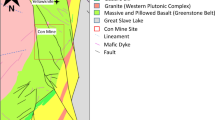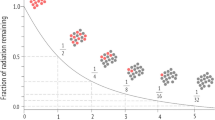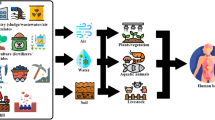Abstract
The candidate repository for high-level nuclear waste in the Gorleben salt dome, Germany, is expected to host 8,550 tonnes of uranium in burnt fuel. It has been proposed that 5,440 waste containers be deposited at a depth of about 800 m. There is 260–280 m of siliciclastic cover sediments above the proposed repository. The potential groundwater contamination in the siliciclastic aquifer is simulated with the TOUGHREACT and TOUGH2-MP codes for a three-dimensional model with 290,435 elements. Two deterministic cases are simulated. The single-phase case considers the transport of radionuclides in the liquid phase only. The two-phase case accounts for hydrogen gas generated by the corrosion of waste containers and release of gaseous C-14. The gas release via a backfilled shaft is assumed to be steady (non-explosive). The simulation period is 2,000,000 years for the single-phase case and 7,000 years for the two-phase case. Only the radioactive dose in the two-phase case is higher than the regulatory limit (0.1 mSv/a).
Résumé
Le stockage proposé dans le dôme de sel de Gorleben, Allemagne, pour les déchets nucléaires de haute activité devrait pouvoir contenir 8,550 tonnes d’uranium de combustible brûlé. On se propose de stocker 5,440 conteneurs de déchets à une profondeur de 800 m environ. Il y a une couverture de sédiments silico-clastiques 260–280 m au-dessus du dépôt proposé. La contamination potentielle de l’eau souterraine de l’aquifère silico-clastique est simulée à l’aide des programmes TOUGHREACT et TOUGH2-MP comme modèle tri-dimensionnel à 290,435 mailles. Deux scénarios déterministes sont simulés. Le scénario mono-phasique considère le transfert des radionucléides dans la phase liquide seulement. Le scénario di-phasique prend en compte l’hydrogène gazeux généré par la corrosion des conteneurs de déchets et le relargage du C-14 gazeux. Le gaz relâché via un puits de mine obstrué est présumé stable (non explosif). La période de simulation est de 2,000,000 ans pour le scénario mono-phasique et de 7,000 ans pour le scénario di-phasique. Seule la dose radioactive du scénario di-phasique est supérieure au seuil réglementaire (0.1 mSv/a).
Zusammenfassung
Das geplante Endlager für hochradioaktiven Müll im Salzstock Gorleben (Deutschland) ist für 8,550 Tonnen Uran in abgebranntem Kernbrennstoff ausgelegt. Es wird angenommen, dass 5,440 Abfallbehälter in ungefähr 800 m Tiefe eingelagert werden. Das siliziklastische Deckgebirge über dem geplanten Endlager ist 260–280 m mächtig. Die mögliche Verunreinigung des Grundwassers im Deckgebirge wird mit den Computerprogrammen TOUGHREACT und TOUGH2-MP in einem dreidimensionalen Modell mit 290,435 Elementen simuliert. Zwei deterministische Varianten werden berechnet. Die einphasige Variante berücksichtigt nur den Radionuklid-Transport in der flüssigen Phase. Die zweiphasige Variante berücksichtigt sowohl die Entstehung von Wasserstoff-Gas infolge der Korrosion der Abfallbehälter als auch die Freisetzung von C-14 in der Gasphase. Es wird hierbei angenommen, dass das Gas gleichmäßig (nicht explosionsartig) durch den verfüllten Schacht des Endlagerbergwerks entweicht. Der Simulationszeitraum beträgt 2,000,000 Jahre für die einphasige Variante und 7,000 Jahre für die zweiphasige Variante. Nur in der zweiphasigen Variante liegt die radioaktive Dosis über dem nationalen Grenzwert (0.1 mSV/a).
Resumen
Se espera que el repositorio candidato para los residuos nucleares de alto nivel en el domo salino de Gorleben, Alemania, aloje 8,550 toneladas de uranio de combustible consumido. Se ha propuesto que 5,440 contenedores de residuos sean depositados a una profundidad de alrededor de 800 m. Existen 260–280 m de una cubierta de sedimentos silicoclásticos sobre el repositorio propuesto. La contaminación potencial del agua subterránea en acuíferos silicoclásticos se simula con los códigos TOUGHREACT y TOUGH2-MP para un modelo tridimensional con 290,435 elementos. Se simulan dos casos determinísticos. El caso de fase simple considera el transporte de radinucleidos en la fase líquida solamente. El caso de dos fases tiene en cuenta el gas hidrógeno generado por la corrosión de los contenedores de residuos y la liberación de C-14 gaseoso. Se supone que la liberación del gas a través del tiraje del relleno es inerte (no explosivo). El período de simulación es de 2,000,000 de años para el caso de una sola fase y 7,000 años para el caso de dos fases. Sólo la dosis radiactiva en el caso de dos fases es mayor que el límite regulatorio (0.1 mSv/a).
摘要
德国Gorleben盐丘是高放核废物处置的候选场地, 将用于贮藏8,550吨乏燃料中的铀。已提议将5,440个废物器皿埋藏于地下800m处。储层上方有260-280m厚的硅质碎屑沉积物盖层。针对可能带来的硅质碎屑含水层地下水污染, 本文采用TOUGHREACT 和 TOUGH2-MP软件建立了三维模型, 且剖分网格290,435个, 模拟了两种确定性情景。单相情景只考虑了液相中放射性元素的迁移。两相的情景考虑了废物罐受到腐蚀释放出氢气与碳-14。假定释放的气体在通过回填井时稳定 (无爆炸性) 。单相模拟期为2,000,000年, 两相模拟期为7,000年。结果表明仅在两相情景下, 放射剂量超过规定限度 (0.1 mSv/a) 。
Resumo
O depósito de resíduos nucleares de alto nível previsto para o domo salino de Gorleben, na Alemanha, espera poder vir a armazenar 8,550 toneladas de urânio em combustível usado. Tem sido proposto que os 5,440 contentores de resíduos nucleares sejam depositados a uma profundidade de cerca de 800 m. Existem entre 260 a 280 m de sedimentos siliciclásticos a cobrir o referido depósito de resíduos. O potencial de contaminação das águas subterrâneas no aquífero siliciclástico é simulado com os códigos TOUGHREACT e TOUGH2-MP para um modelo tridimensional com 290,435 elementos. São simulados dois casos determinísticos. O caso monofásico considera apenas o transporte de radionuclídeos na fase líquida. O caso de duas fases contabiliza o gás de hidrogénio gerado pela corrosão de contentores de resíduos e a libertação de gases C-14. É assumido que a libertação de gás através do poço de acesso ao depósito é estável (não explosiva). O período de simulação é de 2,000,000 anos para o caso monofásico e 7,000 anos para o caso de duas fases. Apenas no caso de duas fases a dose radioactiva é maior que o limite regulamentar (0.1 mSv/ano).










Similar content being viewed by others
References
Beushausen M, Ludwig R (1990) Hydrogeologische Gliederung der oberoligozänen und miozänen Schichten [Hydrogeological classification of the upper Oligocene and Miocene strata]. Report archive no. 106036, Bundesanstalt für Geowissenschaften und Rohstoffe, Hannover, Germany
Bornemann O, Behlau J, Fischbeck R, Hammer J, Jaritz W, Keller S, Mingerzahn G, Schramm M (2008) Standortbeschreibung Gorleben, Teil 3: Ergebnisse der über- und untertägigen Erkundung des Salinars [Description of the Gorleben site, part 3: results of the surface and underground exploration of the salt formation]. Geol Jahrb C73:5–211
Brooks RH, Corey AT (1964) Hydraulic properties of porous media. Hydrology Papers 3, Colorado State University, Fort Collins, CO, pp 1–27
Bundesamt für Strahlenschutz (2010) Lösungsvorkommen im Salzstock Gorleben [The occurrence of fluids in the Gorleben salt dome]. http://www.bfs.endlager/gorleben/loesungen_salzstock.html. Cited on 3 June 2010
Corey AT (1954) The interrelation between gas and oil relative permeabilities. Producer’s Monthly, vol 19, no. 1, November 1954 (quoted by Brooks and Corey 1964)
GSF (2006) Deckgebirgsmodellierung Phase IV: Grundwasserbewegungen im Deckgebirge des Standortes Asse [Cover rock modelling phase IV: Groundwater movements in the cover rock of the Asse site]. GSF Forschungszentrum für Umwelt und Gesundheit, München, Germany
Hughes JD, Sanford WE (2004) SUTRA-MS: a version of SUTRA modified to simulate heat and multiple-solute transport. US Geol Surv Open-File Rep 2004–1207, 141 pp
Javeri V (2006) Three-dimensional analyses of coupled gas, heat and nuclide transport in a repository including rock salt convergence. Proceedings, TOUGH Symposium 2006, 15–17 May 2006, Lawrence Berkeley National Laboratory, Berkeley, CA, 9 pp
Johns RT, Rivera A (1996) Comment on “Dispersive transport dynamics in a strongly coupled groundwater-brine flow system” by Curtis M. Oldenburg and Karsten Pruess. Water Resour Res 32:3405–3410
Keesmann S, Nosek U, Buhrmann D, Fein E, Schneider A (2005) Modellrechnungen zur Langzeitsicherheit von Endlagern in Salz- and Granit-Formationen [Model calculations for the long-term safety of repositories in salt and granite formations]. Report GRS-206, GRS, Braunschweig, Germany
Klemenz W, Rivera A, Wollrath J, Genter M (1998) Three-dimensional coupled groundwater movement and salt transport calculations as part of the safety assessment of the Gorleben repository, Germany. Proceedings DisTec’98, 9–11 September 1998, Hamburg, Germany, pp 591–596
Klinge H (1994) Zusammenfassende Bearbeitung der chemischen und isotopengeochemischen Zusammensetzung der Grundwässer im Deckgebirge des Salzstocks Gorleben [Summary of the investigations on the chemical and isotopic composition of the groundwater in the cover rock of the Gorleben salt dome]. Report archive no. 0111699, Bundesanstalt für Geowissenschaften und Rohstoffe, Hannover, Germany
Klinge H, Margane A, Mrugalla S, Schelkes K, Söfner B (2001) Hydrogeologie des Untersuchungsgebietes Dömitz-Lenzen [Hydrogeology of the Dömitz-Lenzen exploration area]. Report archive no. 0121207, Bundesanstalt für Geowissenschaften und Rohstoffe, Hannover, Germany
Klinge H, Boehme J, Grissemann C, Houben G, Ludwig R, Rübel A, Schelkes K, Schildknecht F, Suckow A (2007) Standortbeschreibung Gorleben, Teil 1: Die Hydrogeologie des Deckgebirges des Salzstocks Gorleben [Description of the Gorleben site, part 1: hydrogeology of the cover rock of the Gorleben salt dome]. Geol Jahrb C71:5–147
Konikow LF, Sanford WE, Campbell PJ (1997) Constant-concentration boundary condition: lessons from the HYDROCOIN variable-density groundwater benchmark problem. Water Resour Res 33:2253–2261
Köthe A, Hoffmann N, Krull P, Zirngast M, Zwirner R (2007) Standortbeschreibung Gorleben, Teil 2: Die Geologie des Deck- und Nebengebirges des Salzstocks Gorleben [Description of the Gorleben site, part 2: the geology of the cover rock and country rock of the Gorleben salt dome]. Geol Jahrb C72:5–201
Lichtner PC (2007) FLOTRAN user’s manual: two-phase nonisothermal coupled thermal-hydrologic-chemical (THC) reactive flow & transport code, version 2.0. Report LA-UR-01-2349, Los Alamos National Laboratory, Los Alamos, NM, pp 1–168
Ludwig R, Mandl J, Uhlig A (1989) Zwischenbericht über die Diskretisierung hydrogeologischer Strukturen im Bereich Gorleben [Interim report on the discretisation of hydrogeological structures in the Gorleben area]. Report archive no. 0105061, Bundesanstalt für Geowissenschaften und Rohstoffe, Hannover, Germany
Ludwig R, Schneider M, Sewing D (1993) Projekt Gorleben: Hydrogeologische Gliederung der quartärzeitlichen Schichtenfolge [Project Gorleben: Hydrogeological classification of the Quaternary strata]. Report archive no. 110256, Bundesanstalt für Geowissenschaften und Rohstoffe, Hannover, Germany
Ludwig R, Schelkes K, Vogel P, Wollrath J (2001) Implications of large-scale heterogeneities for hydraulic model studies at the potential site of a radioactive waste repository at Gorleben, Germany. Eng Geol 61:119–130
Mills RT, Lu C, Lichtner PC, Hammond GE (2007) Simulating subsurface flow and transport on ultrascale computers using PFLOTRAN. J Phys Conf Ser 78:1–7
NAGRA (2002) Project Opalinus Clay: safety report. NAGRA technical report 02–05, NAGRA, Wettingen, Switzerland
Nykyri M, Nordman H, Marcos N, Löfman J, Poteri A, Hautojärvi A (2008) Radionuclide release and transport - RNT-2008. POSIVA Report 2008–06, Olkiluoto, Finland, 164 pp
Oldenburg CM, Pruess K (1995a) Dispersive transport dynamics in a strongly coupled groundwater-brine flow system. Water Resour Res 31:289–302
Oldenburg CM, Pruess K (1995b) Strongly coupled single-phase flow problems: effects of density variation, hydrodynamic dispersion, and first order decay. Paper presented at the TOUGH Workshop ’95, 20–22 March 1995, Earth Sciences Division, Lawrence Berkeley Laboratory, University of California, Berkeley, CA, 6 pp
Oldenburg CM, Pruess K, Travis BJ (1996) Reply to Comment on “Dispersive transport dynamics in a strongly coupled groundwater-brine flow system”. Water Resour Res 32:3411–3412
Pruess K, Oldenburg C, Moridis G (1999) TOUGH2 user’s guide, version 2.0. Earth Sciences Division, Lawrence Berkeley National Laboratory, University of California, Berkeley, CA, 198 pp
Rasmussen TC (2001) Pressure wave vs. tracer velocities through unsaturated fractured rock. In: Evans DD, Nicholson TF, Rasmussen TC (eds) Flow and transport through unsaturated fractured rock, 2nd edn. AGU Geophysical Monograph 42, AGU, Washington, DC, pp 45–52
Roedder E (1984) The fluids in salt. Am Mineral 69:413–439
Roedder E (1990) Formation, handling, storage and disposal of nuclear wastes. J Geol Educ 38:360–392
Saripalli KP, Serne RJ, Meyer PD, McGrail BP (2002) Prediction of diffusion coefficients in porous media using tortuosity factors based on interfacial areas. Ground Water 40:346–352
Schulze O (2002) Auswirkung der Gasentwicklung auf die Integrität geringdurchlässiger Barrieregesteine [Gas generation affecting the integrity of low-permeability barrier rocks]. Report archive no. 0122442, Bundesanstalt für Geowissenschaften und Rohstoffe, Hannover, Germany, 142 pp
Schwartz MO (2009) Modelling groundwater contamination above the Asse 2 medium-level waste repository, Germany. Environ Earth Sci 59:277–286
Schwartz MO (2010) Clearing out Asse 2. Nuclear Engineering International, July 2010. http://www.neimagazine.com/story.asp?storyCode=2057290. Cited 27 Dec 2011, pp 26–27
Serco (2003) NAMMU 7.2 user guide. Serco, Didcot, UK, 262 pp
SKB (2006) Long-term safety for KBS-3 repositories at Forsmark and Laxemar: a first evaluation. SKB technical report TR-06-09, Stockholm, Sweden, 620 pp
Storck R, Aschenbach J, Hirsekorn RP, Nies A, Stelte N (1988) PAGIS performance assessment of geological isolation systems for radioactive waste: disposal in salt formations. Office for Official Publications of the European Communities, Luxembourg, 788 pp
Stührenberg D (2010) Laborversuche an Versatzvarianten in der Oedometerzelle [Laboratory experiments with various backfill types in the oedometer cell]. http://www.geozentrum-hannover.de. Cited 3 June 2010
Suter D, Biehler D, Blasser P, Hollmann A (1998) Derivation of a sorption data set for the Gorleben overburden. Proceedings DisTec ’98, 9–11 September 1998, Hamburg, Germany, pp 581–584
van Genuchten MT (1980) A closed-form equation for predicting the hydraulic conductivity of unsaturated soils. Soil Sci Soc Am J 44:892–898
Vogel P (2005) Orientierende 3-D-Grundwassermodellrechnungen auf den Strukturen eines hydrogeologischen Modells Gorleben [Scoping calculations for a hydrogeological 3-D model structure of the Gorleben area]. Report archive No. 0125865, Bundesanstalt für Geowissenschaften und Rohstoffe, Hannover, Germany, 70 pp
Vogel P, Schelkes K (1996) Influence of initial conditions and hydrogeological setting on variable density flow in an aquifer above a salt dome. Proceedings ModelCARE 96 Conference, Golden, CO, September 1996, IAHS Pub no. 237, IAHS, Wallingford, UK pp 373–381
Xu T, Sonnenthal E, Spycher N, Pruess K (2005) TOUGHREACT user’s guide: a simulation program for non-isothermal multiphase reactive geochemical transport in variably saturated geologic media. Earth Sciences Division, Lawrence Berkeley National Laboratory, Berkeley, CA, 195 pp
Zhang K, Wu Y, Pruess K (2008) User’s guide for TOUGH2-MP: a massively parallel version of the TOUGH2 code. Earth Sciences Division, Lawrence Berkeley National Laboratory, Berkeley, USA, 108 pp
Acknowledgements
This study was carried out with the help of the staff of the Bundesanstalt für Geowissenschaften und Rohstoffe, Hannover, Germany (BGR) but it did not obtain financial support from the BGR or any other organisation. Above all, the report benefited from advice given by P. Vogel (BGR). His experience with alternative software (SUTRA family of codes) proved to be very valuable.
Author information
Authors and Affiliations
Corresponding author
Rights and permissions
About this article
Cite this article
Schwartz, M.O. Modelling groundwater contamination above a nuclear waste repository at Gorleben, Germany. Hydrogeol J 20, 533–546 (2012). https://doi.org/10.1007/s10040-011-0825-z
Received:
Accepted:
Published:
Issue Date:
DOI: https://doi.org/10.1007/s10040-011-0825-z




